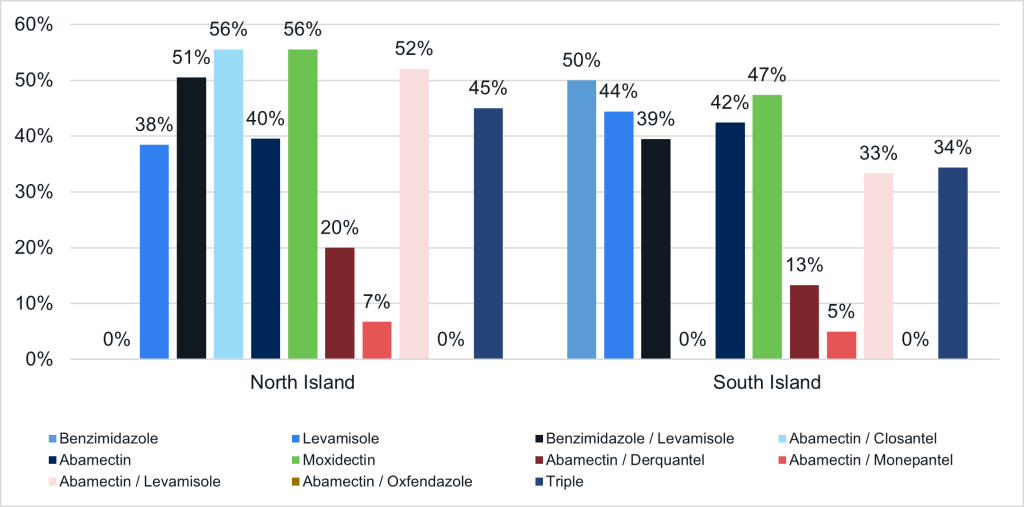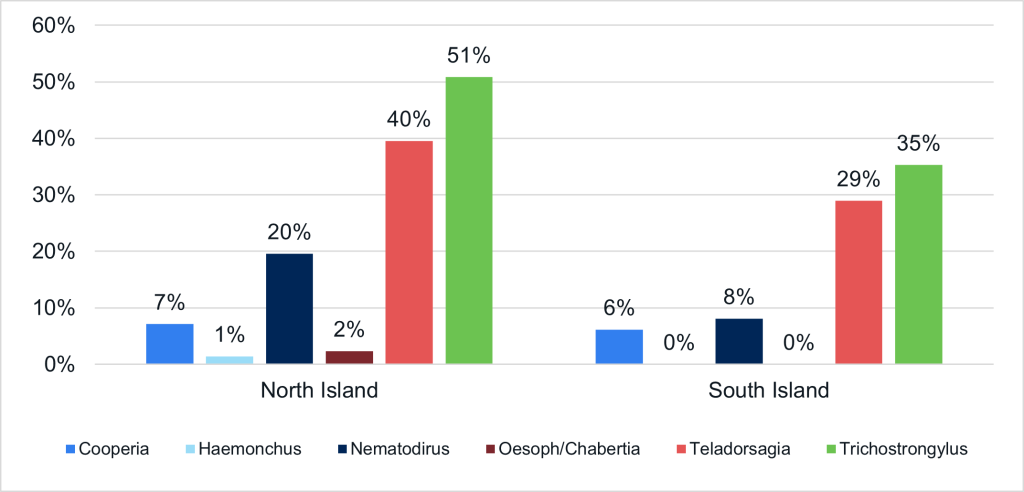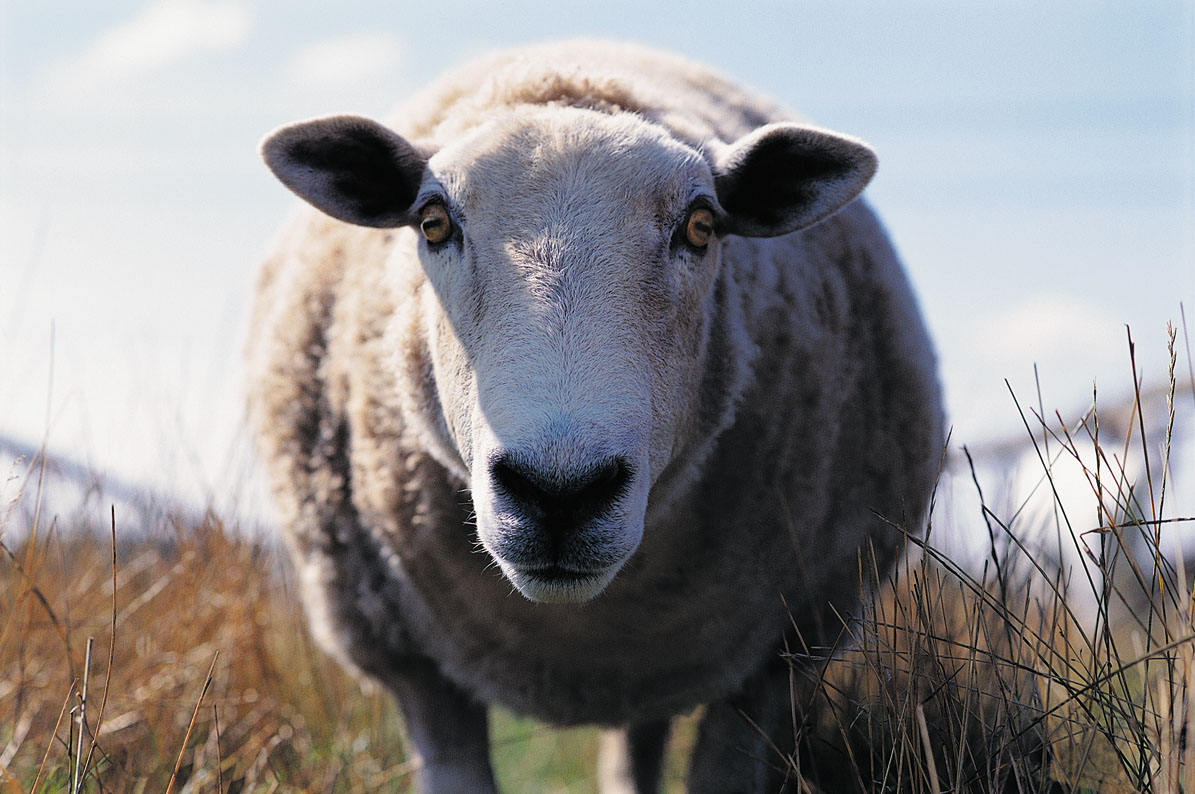Sarah Riddy
This report outlines the analysis of data submitted to the Awanui Veterinary network from June 2023 to May 2024 for fully differentiated faecal egg count reduction tests (FECRT) from sheep. The data was collected from cases where the test anthelmintic and sample groups were clearly identified, with a minimum of 10 animals per treatment group. To be considered valid, data at the genus level required a pre-treatment count of at least 50 eggs per gram (epg) per genus. All other test procedures and methodologies were as described by McKenna (2018).
Data was excluded if there were fewer than 50 epg of a genus in the pre-FECRT count or if the test anthelmintic was not clearly specified on the submission form. This season, only a small number of submissions were excluded due to incorrect identification of drench groups (using colours instead of anthelmintic names or active ingredients). This improvement reflects the ongoing educational efforts about FECRT across various sectors in New Zealand, resulting in a more accurate assessment of resistance nationwide. Submissions not clearly identified as FECRT were also excluded from the study. Additionally, submissions where part of the FECRT was conducted in-clinic, with only the larval culture analysed at Awanui Veterinary, were excluded due to non-compliance with the laboratory’s accreditation and quality standards.
The final dataset included information from 173 farms over this period. The results of the analyses, which cover a total of 115 cases from the North Island and 58 cases from the South Island, are detailed in Table 1.
The percentage of resistance to double and triple active anthelmintics against Trichostrongylus and Teladorsagia spp. has shown a slight increase compared to previous updates (Riddy, 2022, 2023). However, it’s worth noting that the use of double and triple anthelmintics has risen as single anthelmintics have become harder to obtain commercially. Some farms even included two different triple anthelmintic combinations in their FECRTs. Among the 173 farms tested with a triple combination anthelmintic, 51% (99 out of 196) of Trichostrongylus cases exhibited resistance, up from 36% (43 out of 120) reported the previous year (Riddy, 2023).
Table 1: The prevalence of anthelmintic resistance identified in sheep nematodes by fully differentiated faecal egg count reduction tests (FECRTs) undertaken on case submissions to Awanui Veterinary laboratory during 2023-2024 (n=173 farms).
| PARASITE | BZ | LEV | ABA | MOX | BZ/LEV | LEV/ABA | DERQ/ABA | ABA/MONE | ABA/CLO | TRIPLE |
| Cooperia | 0/21 0% | 0/35 0% | 12/60 20% | 16/76 21% | 1/108 1% | 1/95 1% | 1/21 5% | 0/97 0% | 5/9 55% | 7/158 4% |
| Haemonchus | 0/4 0% | 0/13 0% | 0/42 0% | 2/64 3% | 0/84 0% | 0/34 0% | 0/10 0% | 0/82 0% | 0/9 0% | 4/136 3% |
| Nematodirus | 4/10 40% | 3/22 14% | 6/34 18% | 9/27 33% | 8/47 17% | 3/33 9% | 2/6 33% | 3/50 6% | 0/1 0% | 11/76 15% |
| Oesoph/Chabertia | 0/18 0% | 1/30 3% | 0/52 0% | 0/44 0% | 2/80 3% | 0/34 0% | 0/13 0% | 1/54 2% | 0/2 0% | 2/109 2% |
| Teladorsagia | 13/25 52% | 16/38 42% | 29/67 43% | 41/78 53% | 46/112 41% | 25/63 40% | 6/27 22% | 14/101 14% | 5/9 56% | 56/176 32% |
| Trichostrongylus | 14/26 54% | 18/37 49% | 29/69 60% | 53/88 60% | 79/128 62% | 35/70 50% | 9/28 32% | 6/116 5% | 3/9 33% | 99/196 51% |
| TOTAL | 31/104 30% | 38/175 22% | 76/324 23% | 121/377 32% | 136/559 24% | 64/329 20% | 18/105 17% | 24/500 5% | 13/39 33% | 179/851 21% |
Classification of cases by geographical location for both anthelmintic and genus resistance percentages is illustrated in Figures 1 and 2. Figure 1 indicates a rise in resistance for triple anthelmintics in both the North and South Islands, as noted previously. Specifically, resistance in the North Island has increased from 20% and 23% to 45% in this report. Similarly, resistance in the South Island has risen from 8% and 12% to 34%, which is concerning (Riddy 2022 and Riddy 2023).
While passive data collection can introduce challenges in accurately reflecting the true situation on farms across New Zealand, this upward trend should be closely examined in discussions about farm management.

Figure 1: Prevalence of resistance to anthelmintic recorded in sheep FECRTs submitted to Awanui Veterinary laboratories during 2023-2024 for the North Island and South Island (n=173 farms).

Figure 2: Prevalence of resistance to anthelmintic to genus level recorded in sheep FECRTs submitted to Awanui Veterinary laboratories during 2023-2024 for the North Island and South Island (n=173 farms).
Trichostrongylus and Teladorsagia spp.remain the primary species of concern regarding anthelmintic resistance in New Zealand. However, this year’s warmer weather has led to the appearance of Haemonchus in larval cultures further into the season than in previous years.
The data analysed above represents a snapshot of a subset of FECRTs conducted throughout New Zealand, as we can only evaluate the FECRTs submitted to Awanui Veterinary for comprehensive analysis. The results may be influenced by factors such as the location of the submitters, collection methods, and the reasons for conducting the FECRT on each farm. A higher volume of FECRTs submitted to our laboratories would provide a more accurate picture of the situation across the country.
In conclusion, as we adapt our approach to parasite control in New Zealand, Awanui Veterinary will continue to monitor resistance through this passive surveillance method. The combination of education, development of control plans with minimal anthelmintic use, and current data on anthelmintic resistance equips us with effective strategies to address these challenges.
References
> McKenna PB. Update on the prevalence of anthelmintic resistance. VetScript 31 (5), 46–47, 2018
> Riddy SF. Update on the prevalence of anthelmintic resistance 2021–2022
> Riddy SF. Anthelminthic resistance update 2022-2023

